In the previous article on the development of babies 0–3 months old, we talked about seven basic skill blocks.
Now your baby has already reached its first very important milestone in three months and is ready for new exciting activities. By the age of four months, babies can already hold their heads confidently, they communicate with you more and more, you can see a smile on their faces more often, and someone may even start laughing. And, just believe me, the first laughter of a child makes you stunning.
Children are ready for new interesting discoveries and knowledge of the world around them, and you must be prepared for this period.
At the age of 4–6 months, there is much less daytime sleep and more time for a variety of activities. And by the way, to ensure that your baby naps during the day without any problems and sleeps well at night, it is very important to actively engage with them during their waking hours.
In this article, you will explore tips on activities with the child for their development, as well as tips on what developing toys are important and necessary at this age.
Just like previously, we will consider all these tips separately for each of the seven blocks: fine motor skills, gross motor skills, sensory skills, cognitive development, communication and speech, emotional intelligence, imagination and creativity.
Activities for fine motor skills
Activities for fine motor skills for children at this age should be simple, safe, and exciting to help them develop basic coordination and strength of hands and fingers. Read on to find out what this can be.
Ring stacking games
Such a stacking toy is a must-have for this age. These toys help babies develop visual-motor coordination, grasp objects, and manipulate them. This helps to strengthen hands, fingers, and wrists. Thanks to different shapes, sizes, and colors, sensory and cognitive skills are developed as well.

At 4–6 months of age, of course, you shouldn’t expect the baby to stack this pyramid on their own. They still have a lot to learn. So now let’s go through some fine motor skills exercises that you can do with a pyramid right now and that will help them successfully assemble it in the future. Here are they:
- Learn the rings. Allow the babies to explore each ring separately. Offer them one ring at a time and let them touch and feel the texture of the rings. Talk to the child about the colors, patterns, and sizes of the rings while they explore them.
- Practice gripping. Help the baby practice gripping the rings and develop hand strength: place one ring within reach and gently guide the baby’s hand to grasp it. You can say something like, “Can you hold this ring?”.
- Stacking rings. Show how to stack the rings on the central pole. Start with one ring and show the baby how to put it on the pole. Then let them try on their own. Your help may be needed at first, but over time, the baby will learn to stack the rings on their own. At this stage, the sequence of the rings doesn’t matter; we’re just practicing the skill of stacking a ring.
- Tower destruction. As soon as your child successfully stacks several rings, let them enjoy knocking down the tower. This activity helps the baby understand the concept of cause and effect and encourages them to explore the world with their hands.
- Practice pulling up. Pulling down the tower and flipping it over is definitely a lot of fun. And yet, it is very important to teach the child how to remove the rings correctly. Learning to dismantle the tower properly is as important as learning to assemble it. Show the baby how to pull the ring upward to remove it. The “pull-up” motion will come in handy for future activities.
- Sorting by color and size. Once your little one gets acquainted with the rings, you can introduce sorting by color and size. Ask them to hand you a ring of a certain color or size and praise them when they make the right choice. This activity adds a cognitive development element to fine motor skills.
- Rolling rings. Place the rings on their sides, and encourage the baby to roll them on a flat surface. This activity helps them explore the motion of the rings and improves visual-motor coordination.
- Stacking rings on hands or feet. As the baby becomes more skilled, put the rings on their hands or feet and help them take them off. Besides motor skills, there is also an element of imagination involved here when the child needs to imagine that the rings are bracelets for their hands.
Games with sorters
Another must-have toy for this age is a sorter. Capturing small details of different shapes and getting this figure into the hole requires a lot of skills. Such a toy develops visual-motor coordination, agility of fingers and hands. Thanks to different shapes, sizes and colors, it also helps to develop sensory skills, and sorting itself is also a processing of cognitive skills.

Here are some activities you can try with a sorter toy:
- Introduction to shapes. Start by showing the baby various shapes that come with the sorter. Point out the colors and describe each shape, explaining its features.
- Exploration time. Allow the baby to explore the shapes individually. Offer them one shape at a time and let them feel the texture, study it, and practice grasping it.
- Inserting shapes. Since the child may not yet understand how to insert shapes into specific holes on their own, you can do it together. Hold the sorter in front of them and guide their hand to place the shape into one of the openings. Make it a fun and interactive activity. Don’t forget to praise the child and celebrate when you successfully fit the shape into the right hole together.
- Grouping shapes. Place two or more figures in front of the child and ask them to choose one or point to a particular color or shape.
- Building a tower with shapes. Instead of the sorter, stack the shapes in the form of a tower. Offer to knock down the tower: this will be a pleasant activity for the baby and will help them improve their visual and motor coordination.
Games with stackable Cups

This versatile toy helps develop visual-motor coordination, mastering the handling of objects, and also hand, finger, and wrist strength. Thanks to various shapes, sizes, and colors, it also helps develop sensory skills. And playing with the “tower destruction” game engages gross motor skills.
These toys can be used while bathing in a tub or playing in a sandbox.
Here are some ideas on how to play with stackable cups:
Exploring the cup. Just as always, start with an introduction. Allow the baby to explore the cups individually: to hold, touch, and feel them to get acquainted with their texture and shape.
- Stacking cups. Show the baby how to stack the cups on top of each other. Start with two and demonstrate how one fits into the other. Guide the baby’s hand to stack the cups independently.
- Building a tower. Although children of this age may not be able to stack cups vertically yet, you can help them practice by stacking one cup on top of another and showing them how to balance them. This activity helps develop visual-motor coordination and the concept of stacking.
- Tower destruction. After building the tower, show how to knock it down by gently pushing it. Encourage the child to observe and explore this cause-and-effect relationship. Tower destruction game is usually enjoyed by all children. When the child starts crawling, it will have added motivation to reach the tower faster to knock it down.
- Cup spinning (rolling cups). Place one or more cups on the floor and invite the child to roll them. This helps practice reaching and grasping objects while also developing visual-motor coordination.
- Sorting by color and size. Even if your baby cannot yet sort objects by color and size, you can introduce them to these concepts. Show them cups of different colors and name the colors. Also, compare the sizes of the cups to develop visual recognition skills.
Playing with soft rubber toys
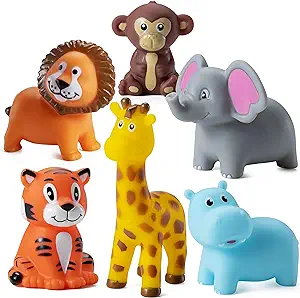
Such soft rubber toys are great for developing gripping skills, and squeezing the toy trains hand strength. Additionally, these toys:
- help develop finger sensitivity due to their various shapes.
- can be used in games like “reach and grab,” which encourages the baby to approach the toy and eventually crawl towards them.
- help in learning animal sounds.
- can be used during bath time, and later, when the baby can sit in the bathtub.
Activities on a play mat
Use a play mat with hanging toys. Babies can reach out and bat at the hanging toys while lying on their backs.
Throwing a ball into a box game
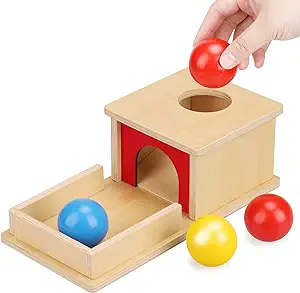
Picking up a ball and dropping it into a box stimulates the fingers and hand muscles, contributing to improving grasping and releasing movements. This game also helps develop movement precision and hand-eye coordination.
When the baby throws the ball into the box, they can see the cause-and-effect relationship. This helps them understand that their actions can lead to specific results, contributing to cognitive development.
Activities for gross motor skills
At this age, babies are still developing basic motor skills, so it’s essential for activities to be simple and safe:
Tummy time
Tummy time can be fun! Lay your baby on their tummy and place toys just out of their reach. Encourage them to reach out with their arms and try to grab the toys. This game will stimulate the baby to learn how to crawl.
Games stimulating movement and crawling
Between 4-6 months old, babies start to learn to roll from their backs to their tummies and prepare for crawling. At first, these movements may be short, but over time, you’ll be surprised at how quickly babies become more agile in their movements. Therefore, games that stimulate movement and future crawling are appropriate at this age.
Stimulation is aided by:
- wobble toys: These toys encourage babies to crawl. Once the baby reaches for the toy and pushes it with their hand, it will move further away, stimulating them to move forward.
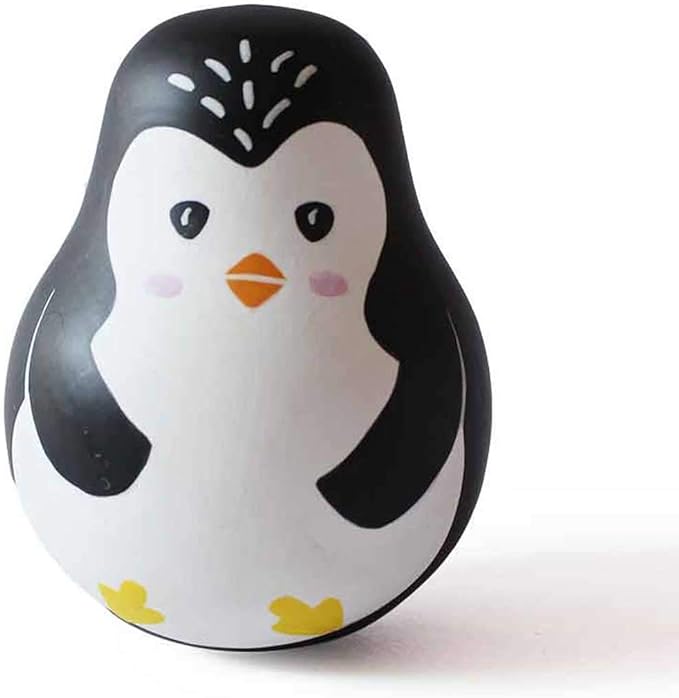
- any other toys you have: rattles, rings from a pyramid, soft rubber toys, etc. Spread these toys around the baby at approximately the same distance. You’ll be amazed at how quickly the baby changes position and reaches them.
Playing with a pyramid (stacking rings)
The pyramid we mentioned earlier also helps develop gross motor skills.
How to play with the baby:
- Place the rings on the floor within reach and encourage the baby to reach for them. To do this, they will need to engage their whole body, turn around, stretch their arms, push off with their feet, and tense their back. This way, the baby develops gross motor skills.
- Hang the rings on the play mat. This encourages the baby to stretch and reach to touch or hit them. This movement helps strengthen the muscles of the arms and shoulders.
Playing with squeaky hammer toy

Practicing hammering helps develop hand muscles. While the baby is still unable to sit independently, you can offer them a hammer to hold in their hands and tap it on various objects while you hold them or while they sit on your lap.
Some activities we talked about in the previous article are still relevant at 4-6 months:
- Play mat time.
- Leg cycling.
- Dancing on your lap.
- Riding on your knees.
- Bathing in the bathtub.
Activities for sensory skills
Tummy time on the play mat
A bright, colorful play mat turns tummy time into a sensory experience.
Besides the play mat, you can also use other soft blankets or small pillows you have at home. Most blankets have different textures, so it will be very interesting for the baby to touch something new.
Exploring textures
Give the baby the opportunity to touch and explore different materials:
- smooth apple and fuzzy kiwi;
- hard book and soft blanket;
- fabric and rubber toys.
While in this activity, you can tell the baby about the different shapes, sizes, and colors of these items and the sensations in general.
Sensory bottles
You can create sensory toys by filling clear plastic bottles with colored water, glitter, beads, or grains. Seal them securely, and allow the baby to shake and observe the contents.
Playing with soft books
Fabric books with bright colors, different textures, and crinkled pages develop both sight and touch. Babies can explore the visual and tactile elements of the book. This is good for developing sensory skills.
Great options here are books like “Who’s Hiding?” or “Who Do You See?”
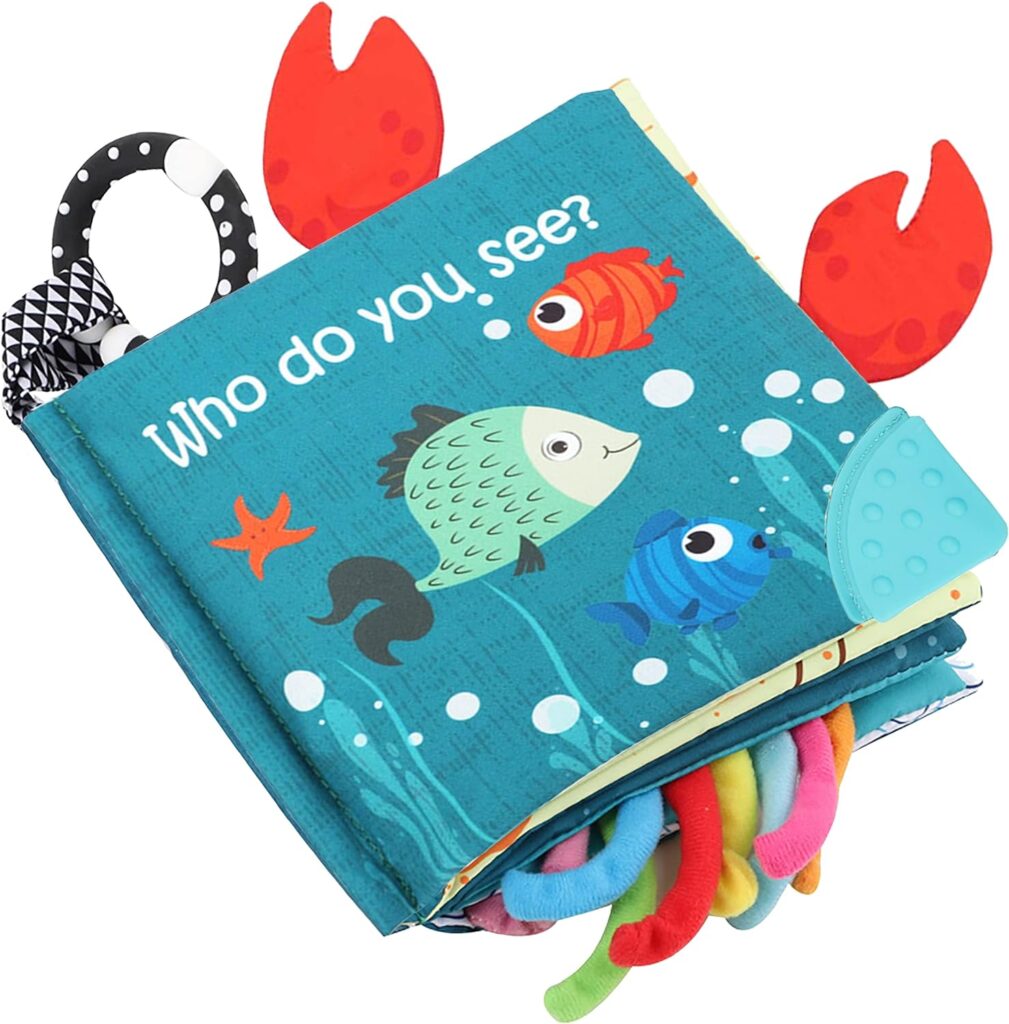
Musical instrument Games
Musical instruments stimulate hearing and introduce children to different sounds and rhythms. Great options include:
- xylophone. In addition to different sounds, it also lays the foundation for understanding cause-and-effect relationships. The xylophone hammer is very light and easy to hold in a small hand. Moreover, hammering itself develops hand strength.
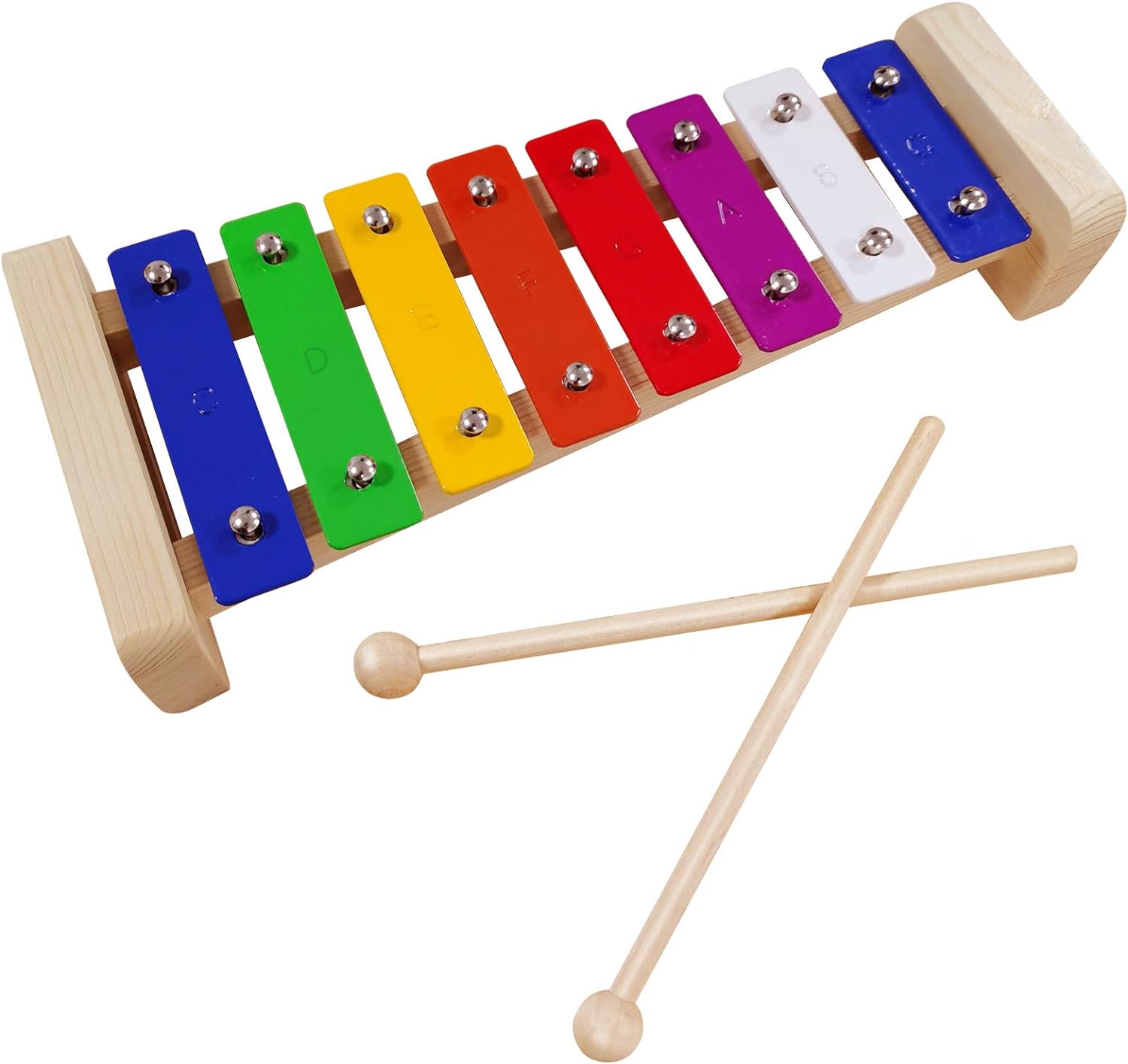
- musical (activity) center. Pleasant melodies and blocks with the ability to make the different sounds develop sensory and cognitive skills. When the baby grows up and can sit independently playing with the musical center, they will dance to many more tunes 🙂
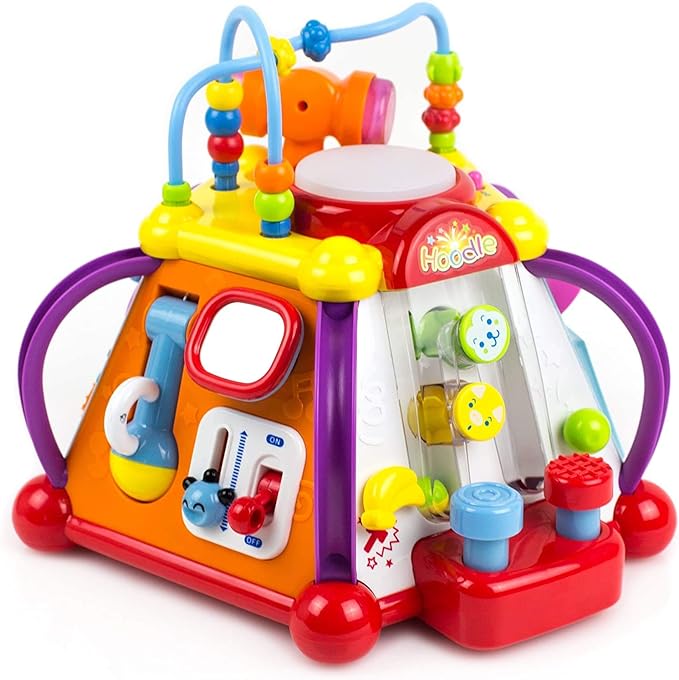
Outdoor walks
Take daily walks with the baby, allowing them to experience the sights, sounds, and textures of the surrounding environment. During walks, be sure to tell the baby what you see, hear, feel, and touch.
Exploring toys with the mouth
The age of 4-6 months is an active teething period, so teethers are still very relevant toys. In addition to teethers, at this age, the baby will want to try other toys with their mouth, please, allow them to do so. Of course, first and foremost, adhere to hygiene and safety rules: toys should be large enough so that the baby cannot swallow them.
Singing songs
Sing many songs to the baby to help them develop listening skills.
Activities for cognitive development
Reading aloud
Read simple books with bright pictures and contrasting colors aloud. Tell the story with expressive voices, and allow the child to touch the book and explore it. Describe in detail what you see in the book.
Reading books even at an early age helps increase attention span. Whenever possible, connect the pictures in books with real-world objects. This helps children establish connections between symbols and their meanings.
Ring stacking games
The ring stacker, mentioned at the beginning of the article, is good not only for developing fine motor skills. The process of stacking and unstacking rings:
- introduces the baby to the concept of cause and effect, a fundamental cognitive skill.
- develops spatial perception, helping the babies understand how objects fit together in a certain order.
- develops basic problem-solving skills and encourages exploration: it allows experimenting with different ways of stacking rings.
We’ve listed many ways to play with a ring stacker, and this variety of interactions with a single toy teaches children from an early age to develop imagination, creativity, and the understanding that there’s always more than one way to solve a problem.
Playing with stacking cups
Stacked or nested cups, mentioned earlier, also help in cognitive skill development:
- understanding cause and effect relationships and spatial thinking.
- learning different colors and sizes.
- learning counting.
As with the ring stacker, there are countless variations of interactions with nested cups, which greatly helps in developing imagination.
Playing with sorters
A shape sorter also helps in cognitive skill development. Inserting and removing shapes helps develop an understanding of cause and effect. During shape sorting, the child learns colors and shapes.
Games with the flash cards
Starting from the age of 4–6 months, you can begin introducing the child to various educational flash cards. By showing the card and naming what’s drawn on it, we help build vocabulary (this is still passive vocabulary) and develop visual memory.
When showing each card, it’s important to name several characteristics of the object – color, shape, edible/non-edible, taste, purpose, etc. For example: Apple. It’s a fruit. You can eat it. It’s sweet. It can be red, green, yellow, etc.
You can alternate quick demonstrations of cards, where you simply show the card, name the item, and set it aside, with a more detailed introduction to the items, using the technique described above.

Basides cards with individual items, it’s also good to use cards where each picture can tell its own story. By telling such a story, you teach the child to describe objects, notice details, concentrate attention, and imagine.
At this age, the child will listen and form their vocabulary, and later, when they grow up and start talking, you will listen to such exciting stories.
Musical toy games
The musical center and xylophone, besides being simply fun to play with, also play an important role in cognitive development. Depending on the buttons pressed or the movements of rotating elements, the baby will hear different sounds. This greatly helps develop understanding of cause and effect relationships and memory.
Peekaboo games
Play peekaboo, covering your face with your hands or soft fabric, and then revealing your face with a smile. This game helps children develop a sense of object permanence, and it’s also very fun and emotionally bonding for children and parents.
Communicative and speech activities
The key two pieces of advice that will help develop your baby’s communication skills:
Firstly, focus on developing fine motor skills, as the development of fine motor skills is closely linked to the development of speech, using the activities described above.
Secondly, communicate with your baby as much as possible. It is during communication that a baby’s vocabulary is formed, as well as understanding how to express their thoughts and emotions:
- Talk to your child throughout the day. Respond to the sounds the child makes as if you are having a real conversation. Speak clearly and naturally, using correct language sounds.
- Describe your actions. How to assemble a pyramid, what colors, what shapes are in these toys, what they do, etc.
- Sing songs and nursery rhymes. Rhyming sentences are easier for a child to remember, thus forming their passive memory. When the baby starts talking, you will find out how many songs the child has memorized from the very first months 🙂 You can also play children’s songs on YouTube and sing along or just listen. Just make sure the song lyrics are easy to understand.
- Read with your child every day. Choose books with bright colors, different textures, and photographs. Describe what you see in the pictures. After reading, you can also briefly retell it in your own words. Try to show your emotions while reading. Express genuine joy and marvel at how the plot unfolds. This way, the baby will understand that reading is truly interesting and enjoyable.
Activities for emotional development
Emotional development is the most important aspect of a child’s overall growth and well-being. It is crucial to create a secure, loving, and sensitive environment:
- Hug your baby as often as possible. Physical touches and hugs are essential for emotional development. Hugs and touches strengthen the bond and emotional security.
- Smile and play peekaboo. Babies at this age are often fascinated by facial expressions. Smile at your baby, play peekaboo, and make funny faces to evoke a joyful reaction.
- Respond to your baby’s cues. Pay attention to your baby’s signals, such as crying, cooing, and facial expressions. A timely response to needs helps the baby feel safe and understood.
- Sing and dance. Singing songs and dancing with your baby can help create a joyful and emotional connection between you.
- Play with soft toys. Soft toys, such as a plush teddy bear, can provide a sense of comfort and security for the baby. The soft texture and familiarity of a favorite toy can help soothe the baby, especially during times of stress or when parents are not around.
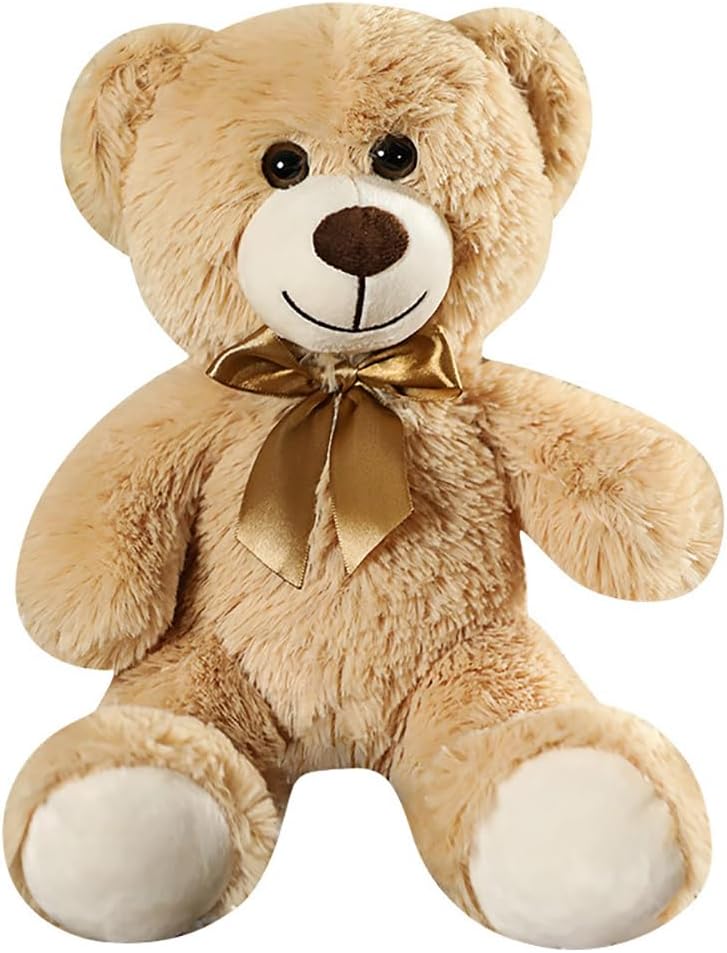
- Stick to a daily routine. Consistency provides the baby with a sense of security and predictability. Babies learn to anticipate events, which can help regulate their emotions.
- Celebrate your baby’s achievements. Rejoice with them. Clap your hands and show excitement when they reach certain developmental milestones, such as rolling over or sitting up. It’s a significant achievement! Also, don’t forget to acknowledge small achievements, like stacking the first ring or correctly placing a shape in a sorter. Such positive feedback will further engage the baby in the activity. And, of course, these moments of shared joy bring you closer together.
Activities for imagination and creativity
Sensory games
Let your child have sensory experiences using soft fabrics, textured toys, and other safe items. These can include various fruits and vegetables, toys, and household items that they can explore through touch and feel.
Offer different textures: smooth, rough, soft, and hard objects. Use soft books and sensory bottles.
Sensory games stimulate curiosity and exploration. Children learn to express their curiosity about the world around them, which is crucial for their imagination and creativity development.
Music
Play music using a music center and a xylophone. Dance together with your baby while listening to this music, and also play other children’s songs. Allow the child to use the music center as they wish. Babies are usually very interested in constantly switching buttons. Let them do it. Let the child enjoy the melody they can create themselves. Later on, they will probably have a favorite one.
Hide and seek games
Hide and seek games help children understand object permanence and also encourage them to imagine where you’ve gone when hiding. Hide behind furniture or a blanket and reappear to surprise the child.
Games that develop imagination
Playing, for example, with stacking cups or a pyramid, you can also engage the imagination to use them in an unusual way. You can make a bracelet for your hand out of rings. Or put a cup on your head and imagine it’s a hat. Or line up the cups on the floor and imagine it’s a barrier or a wall that needs to be overcome.
Show the child a few examples of such activities, and later, the child will find more and more interesting ways to interact with the toy on their own. Encourage them. After each new idea, say something like, “How great and unusual it is that you came up with this! It’s so interesting.”
Playing with animal sounds
You can show the baby an entire performance, portraying different animals, their sounds, and even movements. At first, the child will just watch and try to imitate different sounds, and later on, they will come up with such performances for you. Believe me, it’s very fun and brings you closer together. Also, you can involve all your family members in this game.
Rounding up
The period from 4 to 6 months of a baby’s life is a time of remarkable changes and rapid development. During this period, the babies acquire many new skills, discover the world around them, and establish close bonds with their parents. Every moment of interaction is important, as it lays the foundation for their future development. By supporting the baby in their explorations, we create a solid foundation for their future success.
It is important to remember that each child is unique and develops at their own pace, so special attention and care during this period will create favorable conditions for their health and happiness.
We hope that this article helps you spend time with fun and benefit!






